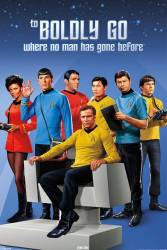Trivia: Gene Roddenberry created the transporter as an easier (and cheaper) way of getting Enterprise crew members onto a planet's surface, rather than landing the ship on the planet.
Who Mourns for Adonais? - S2-E2
Trivia: An ending that was planned but abandoned for this episode would have revealed that Lieutenant Palamas was pregnant with Apollo's child.
Trivia: The Vulcan Nerve Pinch was invented by Leonard Nimoy as a way for Spock to overpower opponents without having to resort to violence.
Trivia: Leonard Nimoy created the hand gesture that Vulcans give when they say, "Live Long and Prosper." He is Jewish, and the spreading of the fingers resembles the hand gesture taken from the ceremony performed by the descendants of the priestly family during holiday prayer services.
Trivia: The slanting crawlway that leads up to the warp-drive nacelles is referred to as a "Jefferies tube." This is a tribute to art director Walter M. Jefferies.
Trivia: The episode "Patterns of Force" was aired only once on German TV, after which it was prohibited to be broadcast by any German TV station again to this day, because of its Nazi theme.
Trivia: Actress Lee Meriwether says she was teased daily by a playful DeForest Kelley while shooting "That Which Survives." He continually pulled down the glued-on cloth rectangle that NBC insisted should conceal her navel, then squinted at her tummy and asked, "What time is it?" On the final day of filming, she got back at him. When Kelley peeled off the cloth, he broke up laughing before he could ask the question. Meriwether had glued a small, ticking clock over her navel - set to the correct time, of course.
Trivia: Before the series went on the air, Gene Roddenberry expressed concerns about the sound effects in Star Trek's intro. He wondered if the "swish" effect of the passing ship should be removed, since there's no sound in space. Desilu Studios polled preview audiences about it; the majority said they liked the effect because it conveyed great speed, and that the scientific inaccuracy didn't bother them. So the "swish" was allowed to remain.
Operation -- Annihilate! - S1-E30
Trivia: Don't know if its intentional or not? This is the only episode of Star Trek, (the Original Series) that I know of, where a person makes a sound after being stunned by a phaser. As Kirk and crew stun the group of men with pipes, listen carefully as the last one falls to the ground. He makes a "oh-ah" or groaning sound. After reviewing all the episodes prior and after. This is the only person who makes any kind of noise after being stunned. Maybe it was the parasite infecting his body that allowed him to do this.
Trivia: A perennial Star Trek extra, the tall blond Eddie Paskey played a red-shirted crewman standing in the background in virtually every Trek episode for all 3 seasons. He rarely had any lines, and was even killed off in "Obsession," but was back on duty anyhow in the following episodes and for the rest of the series.
Operation -- Annihilate! - S1-E30
Trivia: The dead body of Kirk's brother, Sam, is played by William Shatner.
Trivia: Mark Lenard played Sarek, father of Spock (Leonard Nimoy). In real life, Lenard was only seven years older than Nimoy.
The Trouble With Tribbles - S2-E15
Trivia: Prop master Jim Rugg "animated" the tribbles by inserting wind-up toys under their fur to make them crawl, and by supplying some with small balloons and concealed air hoses, making them appear to breathe.
Trivia: Paramount's press releases in 1967 claimed that the Soviet news agency Pravda had complained about Star Trek having no Russian characters, so they were adding Chekov. This story was completely bogus. (Star Trek never aired in the U.S.S.R.) NBC wanted to appeal to the 8-14 teenybopper crowd, and asked Roddenberry to add a character who looked like Davy Jones of the Monkees. So Chekov debuted in season 2, replete with a bad Beatle wig that was, thankfully, soon jettisoned.
Trivia: A constant question during the run of all the Trek series is why Klingons look so much different, from "Star Trek: The Motion Picture" on, than they did in the original series. The real reason is the movies and later TV series had a better makeup budget. However, the "Star Trek: Enterprise" episodes "Affliction" and "Divergence" provide a canon answer. Klingons acquired genetically engineered human embryos left over from Earth's Eugenic Wars and used them to augment their soldiers. It worked but created a virus that threatened to annihilate the Klingon race. Dr. Phlox and a Klingon doctor found a cure, but it resulted in all Klingons becoming far more human in appearance. Sometime between these episodes and the first Trek movie, a cure was found, returning the Klingons to their present day "ridged-head" appearance.







Chosen answer: If they're in orbit, they're being pulled along by the planet's gravity well, therefore, impulse engines would only be used for minor corrections and would be "on standby" while in orbit, but not active. (Like keeping your car idling without revving the engine and creating plumes of exhaust).
Captain Defenestrator
Thank you for the info.
Movie Nut